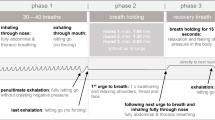Summary
The level of sympathetic nervous activity was assessed by evaluating cardiovascular responses to a cold test in 63 vibration-exposed workers (50 subjects without vibration white finger (VWF) and 13 subjects at stages 1 and 2 of VWF) and in 41 controls. Blood pressure, heart rate, systolic time intervals and the skin temperature of the third finger of the right hand were monitored throughout the cold test period. Basal urinary excretion of free catecholamines and platelet aggregation indices both in vitro and in vivo were also determined in all subjects. Systolic time intervals such as electromechanical systole index (QS2I) and left ventricular ejection time index (LVETI) were found to be shorter in the vibration-exposed workers with and without VWF than in the controls, both at rest and during cold exposure and recovery (p<0.001). A significant inverse relationship between urinary free catecholamines and the duration of LVETI was observed under resting conditions (p<0.03). The recovery rate of the basal finger skin temperature after local cooling was slower in vibration workers with VWF than in those without VWF (p<0.05) and in the controls (p<0.001). Platelet aggregation indices were similar in all groups studied. The results suggest that the level of sympathetic nervous activity is higher in vibration-exposed workers than in controls. In subjects with VWF, sympathetic hyperactivity in combination with local factors such as vibration-induced hyperresponsiveness to cold of the digital vessels may be responsible for finger blanching attacks. The normal platelet aggregation tests, moreover, indicate that stages 1 and 2 of VWF are characterized by vascular disorders of functional origin.
Similar content being viewed by others
References
Atterhög JH, Ekelund LG (1980) Significance of primary T wave aberrations in the electrocardiogram of asymptomatic young men. Part III. Systolic time intervals and autonomic tone. Scand J Clin Lab Invest 40:795–803
Born GVR (1962) Aggregation of blood platelets by adenosine diphosphate and its reversal. Nature 194:927–929
Bovenzi M, Fiorito A, Giansante C, Calabrese S, Negro C (1983) Platelet function and clotting parameters of vibration-exposed foundry workers. Scand J Work Environ Health 9:347–352
Bovenzi M, Giansante C, Fiorito A, Calabrese S (1985) Relationship of haemostatic function, neurovascular impairment, and vibration exposure in workers with different stages of vibration-induced white finger. Br J Ind Med 42:253–259
Drogitchina EA, Metlina NB (1967) On the classification of the vibration disease (in Russian). Gig Tr Prof Zabol 11:27–31
Frey MAB, Kenney RA (1979) Systolic time intervals during combined hand cooling and head-up tilt. Aviat Space Environ Med 50:218–222
Frey MAB, Siervogel RM, Selm EA, Kedzi P (1980) Cardiovascular response to cooling of limbs determined by noninvasive methods. Eur J Appl Physiol 44:67–75
Gemne G (1982) Pathophysiology and multifactorial etiology of acquired vasospastic disease (Raynaud syndrome) in vibration-exposed workers. Scand J Work Environ Health 8:243–249
Gemne G, Taylor W (1983) Hand-arm vibration and the central autonomic nervous system. Journal of Low Frequency Noise and Vibration, special volume. Multi-Science Publishing Co. Ltd, London
Halperin JL, Coffman JD (1979) Pathophysiology of Raynaud's disease. Arch Int Med 139:89–92
Januszewicz W, Sznajderman M, Wocial B, Preibisz J (1968) Urinary excretion of free norepinephrine and free epinephrine in patients with acute myocardial infarction in relation to its clinical course. Am Heart J 76:345–352
Lafferty K, Trafford JC, Roberts VC, Cotton LT (1983) On the nature of Raynaud's phenomenon: the role of histamine. Lancet 286:313–315
Lewis T (1929) Experiments relating to the peripheral mechanism involved in spasmodic arrest of the circulation in the fingers. A variety of Raynaud's disease. Heart 15:7–101
Lewis RP, Boudoulas H, Forester WF, Weissler AM (1972) Shortening of electromechanical systole as a manifestation of excessive adrenergic stimulation in acute myocardial infarction. Circulation 48:856–862
Lewis RP, Leighton RF, Forester WF, Weissler AM (1974) Systolic time intervals. In: Weissler AM (ed) Non-invasive cardiology. Grune and Stratton, New York, pp 301–368
Lewis RP, Boudoulas H, Welch TG, Forester WF (1976) Usefulness of systolic time intervals in coronary artery disease. Am J Cardiol 37:787–796
Lewis RP, Rittgers SE, Forester WF, Boudoulas H (1977) A critical review of systolic time intervals. Circulation 56:146–158
Nerem RM (1973) Vibration-induced arterial shear stress: the relationship to Raynaud's phenomenon of occupational origin. Arch Environ Health 26:105–110
Olsen N, Nielsen SL, Voss P (1981) Cold response of digital arteries in chain saw operators. Br J Ind Med 38:82–88
Olsen N, Fjeldborg P, BrØchner-Mortensen J (1984) Sympathetic and “local” mechanisms in vibration-induced white finger. Proceedings XXI Congress on Occupational Health, Dublin, [Abstr 22] 5, p 192
Okada A, Yamashita T, Nagaro C, Ikeda T, Yalchi A, Shibata S (1971) Studies on the diagnosis and pathogenesis of Raynaud's phenomenon of occupational origin. Br J Ind Med 28:353–357
Pyykkö I (1974) A physiological study of the vasoconstrictor reflex in traumatic vasospastic disease. Work Environ Health 11:170–186
Raynaud M (1862) De l'asphyxie locale et de la gangrène symmétriques des extremités. Leclerc, Paris
Robertson D, Johnson GA, Robertson RM, Nies AS, Shand DG, Oates JA (1979) Comparative assessment of stimuli that release neuronal and adrenomedullary catecholamines in man. Circulation 59:637–643
Spaet TH, Cintron J (1965) Studies on PF3 availability. Br J Haemat 11:269–275
Stafford RW, Harris WS, Weissler AM (1970) Left ventricular systolic time intervals as indices of postural circulatory stress in man. Circulation 41:485–492
Taylor W (1974) The vibration syndrome: introduction. In: Taylor W (ed) The vibration syndrome. Academic Press, London, pp 1–12
Weissler AM, Harris WS, Schoenfeld CD (1969) Bedside techniques for evaluation of ventricular function in man. Am J Cardiol 23:577–583
Yamazaki H, Takahashi T, Sano T (1975) Hyperaggregability of platelets in thromboembolic disorders. Thromb Diath Haemorrah 34:94–105
Author information
Authors and Affiliations
Rights and permissions
About this article
Cite this article
Bovenzi, M. Some pathophysiological aspects of vibration-induced white finger. Europ. J. Appl. Physiol. 55, 381–389 (1986). https://doi.org/10.1007/BF00422737
Accepted:
Issue Date:
DOI: https://doi.org/10.1007/BF00422737




